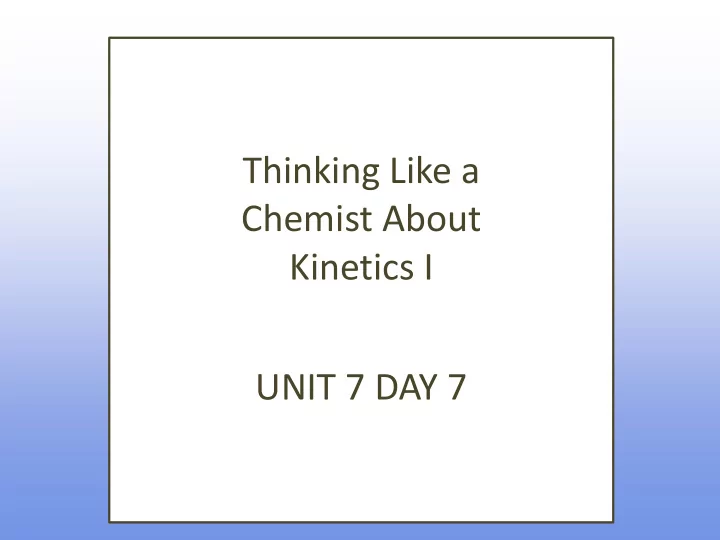

Thinking Like a Chemist About Kinetics I UNIT 7 DAY 7
What are we going to learn today? Practice Method of Initial Rates Investigate the Integrated Rate Law
Kinetics – Review from Last time Imagine the following reaction occurring in one elementary step: CH 3 Br + OH - CH 3 OH + Br - Macroscopic Microscopic -d[CH 3 Br] - ∆[CH 3 Br] k[CH 3 Br] x [OH - ] y = RATE = = ∆t dt Tells us about “ how ” Measured in lab The reaction occurs
Poll: Clicker Question Method of Initial Rates-Empirically Determine Rate Law (CH 3 ) 3 CBr + OH - (CH 3 ) 3 COH + Br - What is the rate law for this reaction? Experiment [(CH) 3 CBr ] o [OH-] o initial rate (M s -1 ) 1 0.1M 0.1M 2.5 x10 -3 2 0.2M 0.1M 5.0 x10 -3 3 0.1M 0.2M 2.5 x10 -3 Rate = k[(CH 3 ) 3 CBr][OH - ] A. Rate = k[(CH 3 ) 3 CBr][OH - ] 2 B. Rate = k[(CH 3 ) 3 CBr] 2 [OH - ] C. D. Rate = k[(CH 3 ) 3 CBr] Rate = k[OH - ] E.
Poll: Clicker Question Method of Initial Rates-Empirically Determine Rate Law A + 2B C The reaction is what order in B? Experiment [A ] o [B] o initial rate (M s -1 ) 1 0.1M 0.1M 2.73 2 0.15M 0.1M 6.14 3 0.1M 0.2M 2.74 A. 0 B. 1 C. 1.5 D. 2 E. 3
Poll: Clicker Question Method of Initial Rates-Empirically Determine Rate Law A + 2B C The reaction is what order in A? Experiment [A ] o [B] o initial rate (M s -1 ) 1 0.1M 0.1M 2.73 2 0.15M 0.1M 6.14 3 0.1M 0.2M 2.74 A. 0 B. 1 C. 1.5 D. 2 E. 3
Poll: Clicker Question What is k? A + 2B C Experiment [A] o [B] o initial rate (M s -1 ) 1 0.1M 0.1M 2.73 2 0.15M 0.1M 6.14 3 0.1M 0.2M 2.74 273 M -1 s -1 A. 27.3 s -1 B. 61.4 s -1 C. 614 M -1 s -1 D. 6.14 M s -1 E.
Reaction Order The degree to which the reaction rate is dependent on concentrations of species. Order of Each Species Overall Reaction Order
Poll: Clicker Question The empirical rate law for the reaction CO + H 2 O CO 2 + H 2 is rate = k[CO][H 2 O] This reaction is overall a A. Zeroth order reaction B. First order reaction C. Second order reaction D. Third order reaction
Poll: Clicker Question The empirical rate law for the reaction CO + H 2 O CO 2 + H 2 is rate = k[CO][H 2 O] This reaction is best described as A.First order in CO and first order in H 2 O B.First order in CO only C.Second order in CO D.Second order in CO and second order in H 2 O
Poll: Clicker Question The empirical rate law for the reaction CO + H 2 O CO 2 + H 2 Is rate = k[CO][H 2 O] What units will the rate constant have? A. M s -1 B. s -1 C. M -1 s -1 D. s -2
Integrated rate laws (the concentration as a function of time) • We need a situation in which either – The rate law depends on only one reactant. OR – Only one reactant is changing much in concentrations, so effectively only one concentration is changing.
Get out Activity Chemical Kinetics
Rate Law First order The rate of the reaction is directly proportional to the concentration of one of reactant For a generic reaction let’ s call that reactant “ A ” -d[A] = RATE = k[A] dt
Integrated Rate Law Integrated Rate Law First order From this: -d[A] = RATE = k[A] dt We can get the Integrated Rate Law : [A] t = [A] 0 e -kt t 1/2 = ln(2) k
Work on Activity
Learning Outcomes Understand the concept of rate of change associated with chemical change, recognizing that the rate of change for a chemical reaction can be determined by experimentally by monitoring the change in concentration of a reactant or product with time. Be able to identify the reaction order for a chemical change. Apply integrated rate equations to solve for the concentration of chemical species during a reaction of different orders
IMPORTANT INFORMATION HW 9
Recommend
More recommend